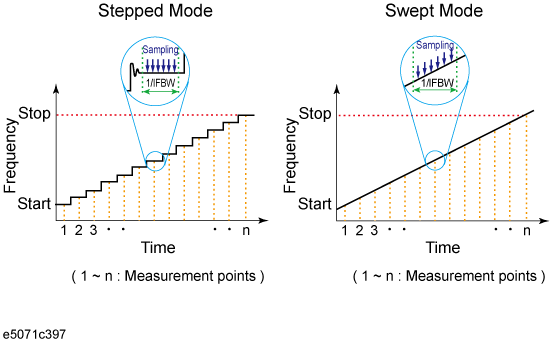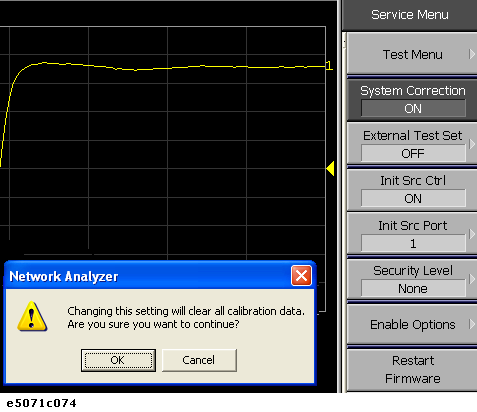
This section explains the methods to improve measurement throughput.
Other topics about Optimizing Measurements
The E5072A provides the two sweep modes: Stepped Mode and Swept Mode.
|
Mode |
Stepped |
Swept |
|
Measurement Reliability |
High |
Low |
|
Sweep Time |
Long |
Short |
|
Restrictions on measurement |
No Particular restriction |
DUT with long electrical delay cannot be measured correctly. |
Press Sweep Setup.
Click Sweep Mode.
Select Stepped or Swept for your appropriate sweep mode.
In the stepped mode, the frequency is changed stepwise and sampling is performed at a fixed frequency for each measurement point. On the other hand, in the swept mode, sampling is performed with the frequency always swept for each measurement point.

In stepped mode, some frequency stabilization time should be allowed before sampling is performed since the frequency is changed stepwise. Therefore, the sweep time in swept mode is generally shorter than that in stepped mode. However, if the measurement point interval is extremely large, the sweep to the next measurement frequency point cannot be completed within the sampling time due to the limitations of the instrument's frequency sweep speed. This causes a certain waiting time until the start of measurement of the next measurement point, and thus in this case the swept mode actually has a longer sweep time.
Although there are some differences depending on the IF bandwidth setting, when the measurement point interval is approximately 30 MHz or less, the sweep time in the swept mode is shorter than that in the stepped mode.
When you use swept mode, you should confirm that there are no measurement-related problems before performing the actual measurement.
Swept mode has the following disadvantages:
DUTs with long electrical delay time cannot be measured correctly. For more information, refer to Notes for measuring DUTs with long electrical delay time.
Trace noise may increase compared to stepped mode because sampling is performed while sweeping the frequency.
The specifications are not guaranteed.
When sweeping the frequency of a signal applied to the DUT (F), there is a frequency difference between the input side and output side of the DUT due to delay time that occurs in the DUT (Delta T). This frequency difference (Delta F) becomes larger as the electrical delay time of the DUT becomes longer and the frequency sweep speed becomes faster, as shown in the following equation.

When measuring a DUT with long electrical delay time, if you perform measurement (sampling) while sweeping the measurement signal as in the swept mode, a measurement error occurs due to the difference between the frequency output at the source port and the frequency actually measured at the receiver port.
Therefore, when measuring a DUT with a long electrical delay time, generally use the stepped mode to prevent measurement error described above. However, if you need to shorten the sweep time, evaluate the measurement error as described below to determine the sweep mode that should be used.
Turning off the updating of information displayed on the LCD screen eliminates the processing time required to update displays within the analyzer, improving measurement throughput. If it is not necessary to check displayed information during measurements, turning off real-time updating is an effective means of improving throughput.
The updating of information displayed on the LCD screen can be switched using the following procedure:
Press Display.
Click Update to switch the updating of displayed information on the LCD screen on/off.
When the LCD screen update is turned off, Update Off appears on Instrument Status Bar.
The E5072A executes Port Characteristics Correction in the data processing flow shown in Data Processing Flowchart, by using the system calibration data set at the factory. This system error correction process is not required if the user performs proper calibration by using Cal and softkeys that subsequently appear, which automatically turns on error correction.
By turning off system error correction, you can reduce data processing time needed during measurement and thus improve measurement throughput.
When you turn ON/OFF system error correction, all calibration data set by user calibration is deleted.
Click Service Menu > System Correction.

Click OK to turn ON/OFF system error correction.